Long before the modern era of computers, cellphones, smartphones, fiber-optic cables and the internet, long distance electric/electronic communication consisted primarily of the telegraph and telephone. The electric telegraph (in the United States) was developed by Samuel Morse in 1837, and the first message was sent by Morse in 1838. The telephone was invented by Alexander Graham Bell in 1876.
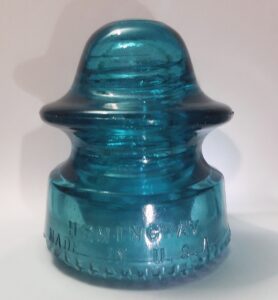
As time went on, networks of “open wire” telegraph lines, and later, telephone lines, were developed and built throughout the country, and these lines required the installation of insulators. Insulators were necessary by serving as a medium for attaching the wires to the poles, but much more importantly, they were required to help prevent electric current loss during transmission. The material, glass, is itself an insulator (not a “conductor” or “transformer” as insulators are often incorrectly labeled in antique malls and flea markets).
Both glass and porcelain insulators have been used since the early days of the telegraph, but glass insulators were generally less expensive than porcelain, and were normally used for lower-voltage applications. The oldest glass insulators date from about 1846.
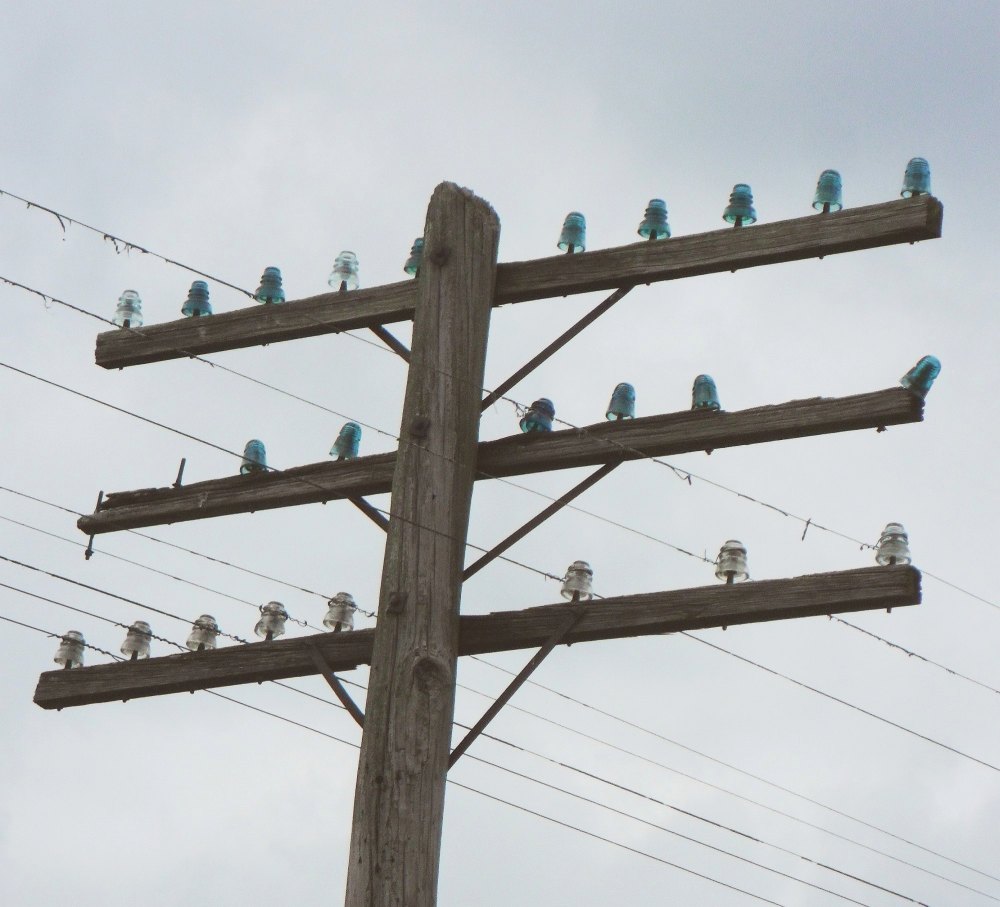
The period from 1875 to 1930 might generally be thought of as the “heyday” of the glass insulator. Hundreds of millions of these glass “bells” were produced during this time by many glasshouses, located primarily in the East and Midwest with a few plants in California and Colorado. Many of the glasshouses that made insulators also produced bottles, fruit jars and other glassware.
Most insulators are found in some shade of aqua (blue-green) colored glass (typical inexpensive “bottle glass” or “green glass”) but many, many other color shades are found. Clear glass was used (with some exceptions) primarily after about 1935. Hundreds of different styles were developed over the years, and insulators are found with a wide variety of embossed names, initials, patent dates, and other markings.
“CD” NUMBERS
All glass pintype insulators are classified in what is called the “CD Numbering” system of identification. This system was created and used by N.R. “Woody” Woodward, an early pioneer, researcher and author in the field of collecting glass insulators. The CD (Consolidated Design) numbers basically identify insulators by their shape and profile, regardless of exact embossed markings, glass color, or base type.
For instance, “CD 154” is the CD number assigned to the most common style of glass insulator ever made, and that most likely to be seen by the average person………… the HEMINGRAY-42. Several other glass companies besides Hemingray Glass Company made the same basic model, although their versions may have raised markings, color, and base types (smooth base, sharp drip points or round drip points) that differ. But all of them would be known as CD 154s. Here’s a few other commonly found insulators: Hemingray NO. 9 is classed as a CD 106. Hemingray-10 is a CD 115. Hemingray-12 is a CD 113. Armstrong DP 1 is a CD 155. Hemingray-45 is also a CD 155. Kerr T.S. is a CD 129. There are several insulator websites that discuss this classification system in more detail.
Nearly all insulator collectors who are affiliated with the “organized hobby” of insulator collecting use CD numbers for more clarity when communicating with other collectors by mail, email, text or phone. CD numbers are used on many ebay auctions, although non-collectors who list insulators on ebay or other internet sales sites may not be familiar with the system.
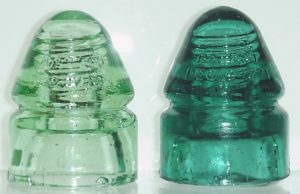
Many earlier insulators have bubbles, streaking, “snow”, surface creases and other marks of crudeness which was common for this type of glass because quality standards were not usually set as high as tableware. As long as the insulator performed it’s duty adequately, the color and minor imperfections in the glass were of little concern. These “marks of crudeness and age” now add to their value and charm to collectors of antique insulators.
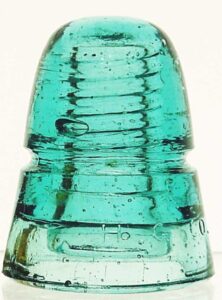
Old photos from around the U.S. show many telephone, telegraph and electric power poles sporting large numbers of insulators arranged on crossarms. Some telephone poles (in large cities) carried as many as 20 or more crossarms, each one bearing six, eight, 10 or 12 (or even more) insulators.
Each insulator was attached to the crossarm by being screwed onto threaded wooden or metal pegs, known as “pins”. A steel or copper tie-wire was attached to the insulator, and connected with the communication wire. These “pintype” insulators were an extremely commonplace sight, and communication lines with insulators were strung alongside most roads, highways, and railroads.
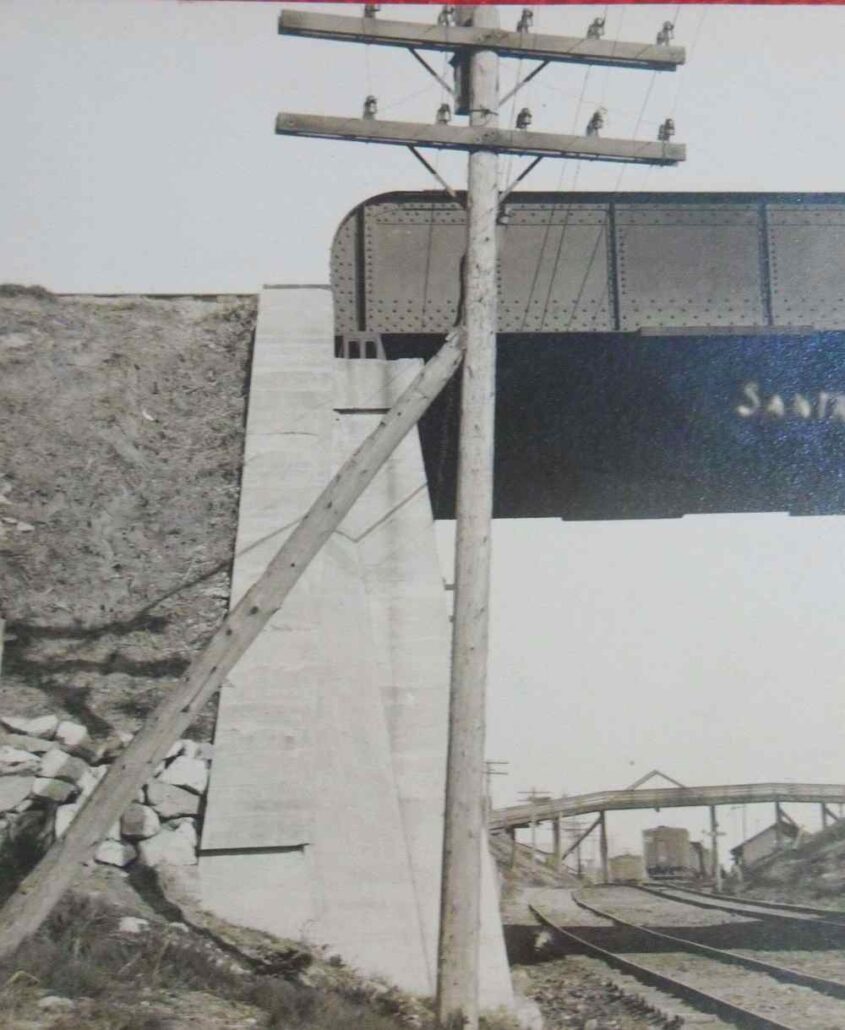
During the 1960s, 1970s and 1980s many of these lines were dismantled as technology advanced. Today, a few lines using glass insulators are still in service, but are only a tiny percentage compared to the heyday of open wire communication.
ADVERTISEMENT
Insulators (generally speaking) are still commonly in use, but insulators of the modern era (speaking of the United States in particular) are usually heavier, high-voltage types used in electric power line transmission and distribution, and are of porcelain (“ceramic”) or polymer (plastic) construction. Most modern telephone lines now make use of insulated sheathed cable, and many are underground.
Today, vintage glass insulators are a collectible item in their own right, often saved, studied and displayed along with antique bottles, tableware and other early glassware. The majority of glass insulators carry embossings (raised lettering), as previously mentioned, including company names, brands, trademarks, or model numbers, patent dates, etc. A small percentage of insulators are entirely unmarked. Perhaps somewhat surprisingly, so many insulators are found that were carefully and rather painstakingly lettered with markings that would not even be discernible by the average passersby below – only visible to linemen (and birds) !
Collectors of insulators often specialize in a particular glass companies’ products, or in certain styles, shapes or colors of insulators. They might delve into the history of a particular company, what styles where made and when, the markings used, etc. Besides the more typical “pin type” communications/electric power line insulators, other sub-categories include lightning rod insulators, radio wire or guy wire “strain” or “egg” style insulators, inside home wiring knob or spool insulators, and battery rests.
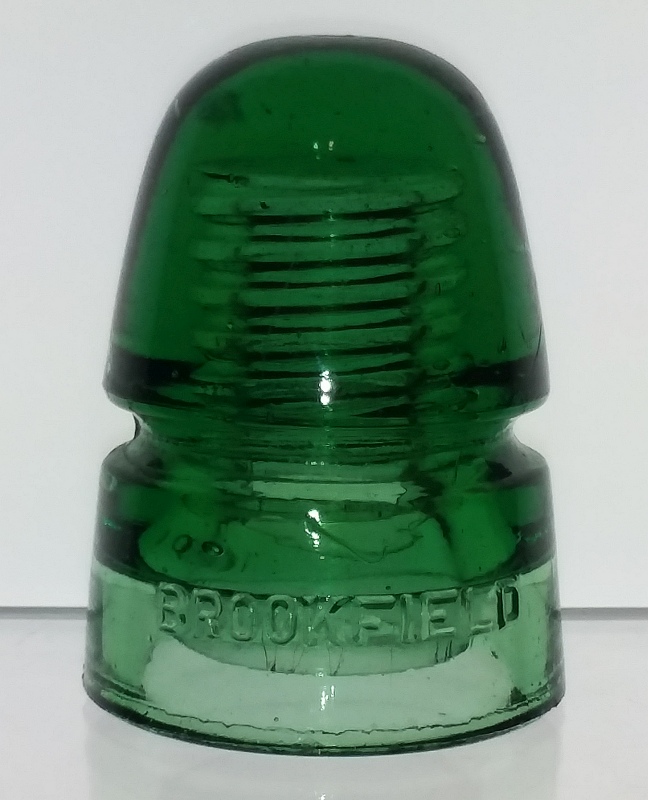
MOLDS
Many, many different cast iron or steel molds were used over the years to produce glass insulators, and the collection & study of old insulators can be compared, in some respects, to numismatics (the study and collection of coins). Most earlier insulators were made by forcibly pressing molten glass into a mold. The mold was momentarily closed, and then within a few seconds was opened and the finished insulator was removed to be placed into a lehr (cooling oven). Modern glass insulators are/were made by mass-production machine pressing methods.
On earlier insulators, many minor variations in the engravings cut into the inside surface of the molds resulted in slight differences in the exact appearance, size and placement of the raised lettering seen on the surface of the glass. On some companies’ products, more than one style of lettering can be identified. For instance, the so-called “Script”, “Prism” and “Stamp” (“Typewriter”) styles of font which are seen on many Hemingray insulators.
Sometimes an individual mold can be identified by studying and comparing insulators that were produced from it over a considerable stretch of time. Changes in the mold, such as re-cut (re-tooled) engraving, repair, or the addition or erasure (“blotting out”) of the engraving can be discovered upon very close inspection of the insulator. Thus, the comparison I’ve made to the coin collecting hobby, with the many slight differences in coin die design details, as revealed under close scrutiny by serious collectors.
So-called “END OF DAY GLASS” Insulators
Contrary to what might be assumed from some internet articles, and printed reference material published over the years, the GREAT MAJORITY of glass insulators (at least here in the United States) were NOT made with so-called “End of Day” glass.
Some smaller glassmaking operations, especially before around 1900, likely sometimes used up leftover molten glass in their pots (after filling an order for another type of glass item) to make insulators, but there is little evidence this was a widespread practice. Boston & Sandwich Glass Company of Sandwich, Massachusetts (1825-1888) might have made some insulators that could rightly be considered “end of day” glass.
Note: “ZICME” embossed insulators (made in Bogota, Colombia by Zundel Industria Colombiana Materiales Electricos – 1960-1966) are believed, by some collectors, to have been made with “end of day glass” (because of the wide variety of beautiful and “odd” glass colors found) but in reality the factory simply used a lot of recycled glass (cullet) from broken bottles and other items, using hand-pressed methods. This may also be true of some very old Canadian threadless insulators (like CD 718) that have been found in a wide range of rather odd colors (even a shade close to “cranberry red”)!
But as far as the more common, typical glass insulators most often encountered in the US, the great majority of those were made by large glass companies (Hemingray, Brookfield, Whitall Tatum, Armstrong and others) that produced insulators in HUGE volume, and the concept of “end of day glass” is entirely foreign to the way they operated – churning out multiple train car loads of insulators every day, producing millions and millions of mass-produced insulators.
ADVERTISEMENT
TRAINWATCHING & INSULATORS
Because virtually all railroads (that were built in or before the 1950s) originally had communication lines strung alongside them (primarily telegraph, but also in some cases telephone), railroad buffs (“rail fans” or “trainspotters”) sometimes become interested in glass insulators since they were such a common sight along old railroad rights-of-way.
Railroads, trains, and telegraph lines and insulators have had a long history of being interconnected. Huge numbers of old photographs of railroads, trains and railroad-related scenes from across the United States show the telegraph lines with insulators in place – in their “original habitat”, so to speak. And modern model railroading layouts sometimes include miniature telegraph poles with tiny “insulators” to help recreate the “look” of an earlier era.
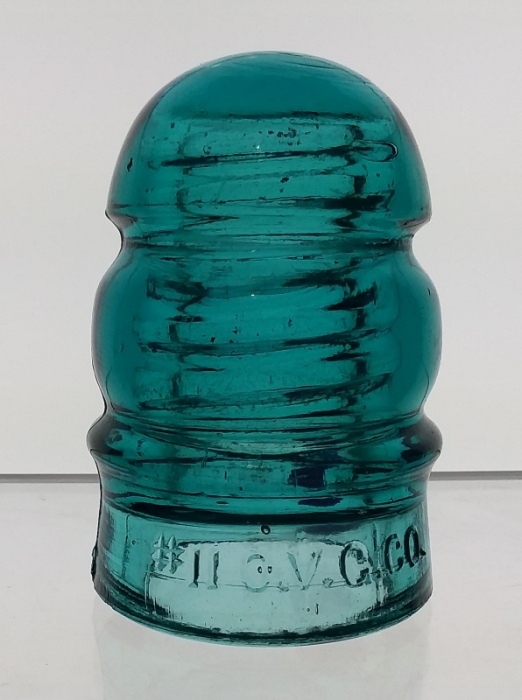
Today, most railroads in the US no longer have a telegraph line next to the tracks. But old-timers know what a beautiful sight it once was to look far down the railroad tracks and see a long, long line of telegraph poles, each adorned with glittering glass insulators, especially as seen against a setting sun!
Cleaning Insulators
Most insulators are typically found in a very dirty condition, often coated with a layer of gray or black “train soot”, or dirt and grime accumulated over many, many years of service in the outdoor environment. The underside surfaces in the skirt area are often heavily stained with a coating of stubborn train smoke. Insulators installed along railroads typically are coated, to some degree, with black soot. Sometimes the layers of soil are so heavy that the true color of the insulator cannot be discerned.
Often, new and casual collectors don’t know how to clean insulators so the true beauty of the glass can be seen and fully appreciated. Most serious insulator collectors do not keep their insulators in “as found” condition, preferring to clean them, although some collectors do keep a few pieces in their collection in their “originally found”, dirty condition just for more authenticity or “history’s sake”.
First of all, let me say that trying to clean insulators (thoroughly) using simple soap and water is almost a waste of time and effort. Dishwashing liquid and warm water can be used to remove some of the surface dirt and grime, but the best way to cut the heavy black soot on many old insulators is by using oxalic acid. There are several ways to clean insulators, but the easiest (in my opinion) is to soak the insulator in a product that contains the active ingredient oxalic acid.
Oxalic aid is usually very effective in breaking down the stubborn layers of train soot which can be VERY difficult to remove if using ordinary cleansers, soaps and detergents. Oxalic acid is an ingredient in certain brands (but not all) of so-called “Wood Bleach” or “Deck Cleaner”. (Behr’s markets their version as “All-in-One Wood Cleaner” and it does contain this ingredient). Usually, a one gallon plastic container of deck cleaner can be mixed with 2 to three gallons of water in a five-gallon plastic bucket. (DO NOT USE METAL CONTAINERS OF ANY TYPE!). Oxalic acid can also be bought in crystal form (like a fine white powder). Oxalic acid is technically a poison, so using plastic gloves when handling it is strongly recommended. (Caution: oxalic acid cannot be used to clean Carnival Glass insulators, as the carnival coating may be dissolved).
Bar Keepers Friend
The simplest and more inexpensive method is to use the product “Bar Keepers’ Friend” which contains a diluted form of oxalic acid, and that product is sold in most large general department stores and grocery stores (usually stocked next to the cleaning products “Ajax” and “Comet”). One can of BKF can be mixed into a 5 gallon plastic bucket of water (slightly lukewarm or room temperature). The insulators are carefully immersed and left to soak for at least 24 hours. Two days would be better. Since BKF contains oxalic acid in a more diluted form, it may or may not be as effective as other products, but it is usually a reasonably good cleaner of glass. After soaking, remove the insulators, using plastic gloves, and scrub carefully with NON-scratching cleaning pads or OOOO-grade steel wool. Most insulators will respond well to cleaning with BKF, although some may not. Some insulator collectors use lye as a cleaner, but I do NOT personally recommend it unless you are VERY, VERY careful and take ALL precautions as directed on the product label.
GLASS INSULATOR VALUES
As I’ve mentioned elsewhere on this site, my main purpose here is to concentrate on the background and history of the glassware being discussed, not on values or prices. This site is not intended as an appraisal source so little attention has been given to values. However, since the subject of values does come up often when people write to ask about insulators they’ve found, I feel that it is best to address the issue in this article.
Many times collectors are asked “How much are insulators worth?”. Well, this question might be compared to a question such as “How much are blue cars worth?”. The question simply can’t be answered quickly and easily when discussing insulators as a whole. The answer depends on so many variables.
All insulators, glass and porcelain, in my opinion, have some value. (Other collectors may strongly disagree with me on this point, but that is their prerogative). The value might relate only to the fact that a piece is an authentic relic of bygone days, or an object that can serve as a conversation piece or item of home decor.
The value may stem only from the fact that an insulator is a piece of United States history (or another country’s history) that is no longer being manufactured — a piece of “industrial archaeology”, so to speak. Or that perceived worth may lie solely in its practical value as an insulator, or that it’s still perfectly good for other uses such as paperweights or candleholders. A heavily chipped, cracked insulator with almost no monetary value to collectors could theoretically still be perfectly useable in the practical sense (as a farmer’s livestock fence insulator, or installed on a short telephone line in a rural area, for instance).
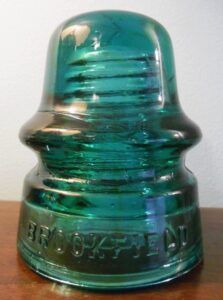
The majority of the most commonly found types of glass pintype insulators have only nominal monetary collector value, perhaps 50 cents to a dollar. This includes the extremely common types such as the Hemingray-42, Hemingray- 12, Hemingray-45 and Whitall Tatum No. 1 and others. However, even within the common types of insulators, differences in glass color, embossed markings or base type can make huge differences in the market value of a specific piece to experienced collectors.
A notch above the most common types will be found many insulators that range in the 1 to 5 dollars value bracket. There are many harder-to-find types that are worth in the neighborhood of $10 to 20, or $25 to 50 dollars or more. Still others are worth hundreds, and some of the rarest known insulators (some of them “one of a kind”) are valued in the thousands and tens of thousands of dollars.
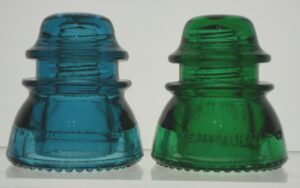
Again, it depends on a combination of characteristics including shade of color, degree of scarcity, condition, collector demand, age, attractiveness, and other factors such as the area of the country where a piece is listed for sale. Damaged insulators, speaking strictly of monetary value, in most cases are worth only a small percentage of the value of an otherwise identical “Very near mint” (VNM) piece. The value of a heavily damaged insulator may be diminished perhaps 40% to 90% compared to a similar piece in excellent condition, although a very scarce or rare insulator may still have considerable value even with cracks and heavy chipping.
Insulators placed for sale in retail outlets such as antique malls and flea markets will, by necessity, usually be priced higher simply because of factors such as overhead – sellers typically have to pay steep booth rental fees in such places as antique malls.
The most commonly used glass insulator price guide (used by most insulator collectors) has been published for many years, in several editions, first by John & Carol McDougald, and in more recent years by Don Briel. A quick search of the web will bring up sites where those books can be purchased.
There are other websites that discuss the general subject of values and prices. One tactic many collectors use is to do keyword searches on ebay or other internet sales sites such as Etsy. In using those sites it is best to consider only the price of a piece that actually sold (by searching “Completed Items” on the advanced search page), NOT the starting prices, “Buy it now” prices or minimum bids, as these may be set by sellers who honestly have no idea on the actual value of the pieces they are selling, and so come up with a price that is unrealistic.
ADVERTISEMENT
For a listing of some primary embossings found on glass insulators, and the glass factories that may have produced them: Glass Insulator Embossings.
Detailed article on the “HEMINGRAY No. 9 / PATENT MAY 2 1893” pony style insulator used primarily on telephone lines.
Here are a few individual webpage articles on glass insulator companies (here on the GlassBottleMarks.com site) :
Brookfield Glass Company
Hemingray Glass Company
California Glass Insulator Company
Lynchburg Glass Corporation
McLaughlin Glass Company
Whitall Tatum Company
Ohio Valley Glass Company
List of Glass Factories that manufactured Insulators
For a list of glass factories/companies in the United States that made electrical insulators, (or are believed to have made them at some time in their history), please click here to go to my page listing those companies in alphabetical order: Glass Insulator Manufacturers
Please click here to go to my website HOME PAGE.
For a list of marks seen on bottles, fruit jars, tableware and insulators, click here to go to my alphabetical listing: GLASS BOTTLE MARKS (this points to page one).
Click here to check out my page on the so-called “Crackle Glass” insulators.
My webpage discussing recently color-altered glass, including insulators and other types of collectible glassware: Artificially Purpled Glass.
Click here for a basic summary page on WHAT IS GLASS?.
RESOURCES / GENERAL INFO CONCERNING INSULATORS
These are great sources of information posted on other websites. I would encourage anyone who has even a slight interest in glass and/or porcelain insulators to check out these websites!!
Insulators.info. Lots of good general information on Glass & Porcelain insulators and the hobby of collecting insulators!! A treasure-trove of articles and webpages on all aspects of collecting insulators! This should be your first stop on the internet for insulator-related material!
https://nia.org. (National Insulator Association) . Great information and articles on many types of insulators, including glass and porcelain, etc.
https://www.collectinginsulators.com. Rick Soller’s informational website—this site covers a lot of insulator-related “specialty” topics!
https://www.r-infinity.com/ Elton Gish’s very cool website with extensive information on collectible porcelain insulators of all types.
Porcelain Insulators – Insulators.info This link points to one of the pages on insulators.info, this page illustrating some of the markings seen on porcelain insulators. Great pics of some more unusual colored porcelain pieces!
https://allinsulators.com/ This site is a project by Shaun Kotlarsky, and is a work in progress, showing pictures and information concerning all kinds and types of insulators! Check it out!
https://www.hemingray.info/ This website by Christian Willis has TONS of superb information on all known types of Hemingray-made glass insulators! If you have any questions about Hemingray insulators, check this site!!
https://lynchburgglass.info/ Dennis Bratcher’s site with lots of detailed information about Lynchburg Glass Corporation and Lynchburg insulators!!
ADVERTISEMENT

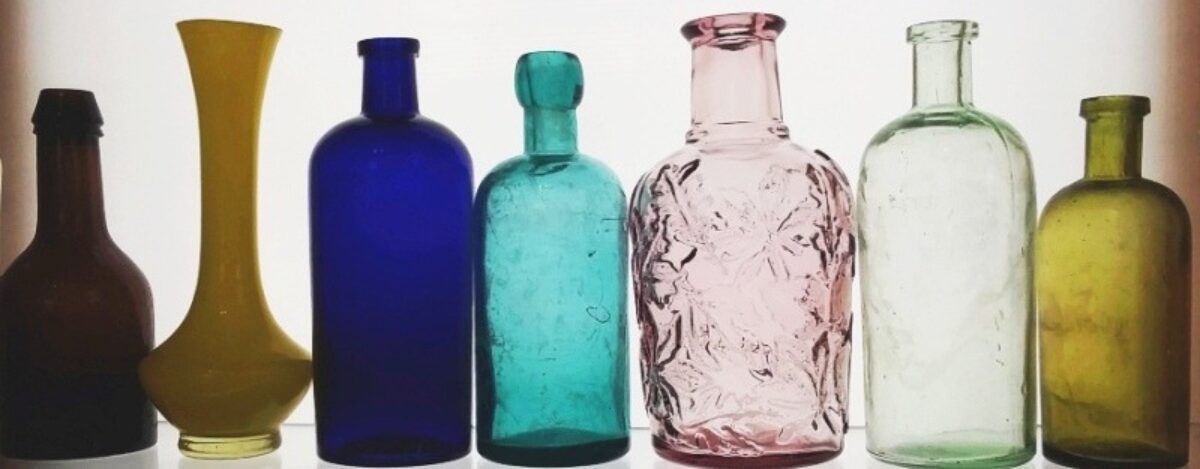
Thanks for taking your time to identify and provide dates for vintage insulators. Your site is very informative and i am going to bookmark the page for reference when identifying the varieties I come across. I am fascinated by old glass insulators and bottles and some of the early ones are really, really cool! I would like to find an early beehive (aqua, like the one pictured towards the top of the page) variety some day. Blessings!
Hi Larry,
Thanks for the post! Good luck with your search for insulators!
David
Hello! Can you tell us anything about the wood used inside the insulators. Also what tools were used to connect the wire to the insulator. I enjoyed reading about the different insulators you wrote about but would like to know more of how things were brought together.
At a museum in Florida, at Torreya St. Pk., they presented wooden pieces with a screw type carving on one end and rounded or squared at the other end. They also had angled wooden cuts with a screw like projection on the other end which we think were nailed to the crossbeam on the pole. Also what did they use to put the wire around the insulators. It couldn’t have been done all by hand could it?
Thanks for any help on this subject.
Sincerely
Maggie Wright.
Hi Maggie,
The wooden insulator “pegs” or “dowels” are more properly called (using the more correct terminology in the industry) “pins”. I don’t have much in-depth information on them, but I do know that the most popular woods used for insulator pins were black locust and oak. Some sources also mention elm and eucalyptus wood. The linemen who erected, maintained and repaired telephone and telegraph lines used a variety of metal tools for their work. There may be more information online about the tools used by earlier linemen but I’m really not familiar with them.
Here are a few online articles that have some information relating to the wooden pins used to attach the insulators to the poles:
Archived article from “Proceedings of the American Electric Railway Association, New York, NY, United States, 1920”, about specifications for pins used with pintype insulators:
https://reference.insulators.info/publications/view/?id=8634
A visit to a modern-day wooden insulator pin manufacturer (article from 1997):
https://www.insulators.info/articles/pinmaker.htm
Brief discussion on telegraph line construction with info on insulators and insulator pins, this is from 1897:
https://reference.insulators.info/publications/view/?id=7987&h0=locust&h1=insulator&h2=pin
“Western Electric” trade magazine article about strengths of various woods used for the fabrication of insulator pins, from 1907:
https://reference.insulators.info/publications/view/?id=10124&h0=oak&h1=locust&h2=pin
Hope this helps a bit!
David
Hi there. Maybe you can help me. I have a dark peach Hemingray insulator marked with T.S. on one surface and on the opposite side there is 18-59: . I cannot find it online. I think TS is pretty common, but the color is a medium peach shade. I also have purple one Hemingray – 9. 8-48: My mom and dad moved out of their house and I found these.
Hi Sandy,
I am sorry to report that your “dark peach” Hemingray T.S. insulator has either been stained on the outside surface, OR it has been irradiated (“nuked”) to artificially change the color. Your insulator was originally clear or off-clear in color and is classed as a CD 129 in the “Consolidated Design” system of catalog numbers used by insulator collectors. You can search google with the keywords: Hemingray T.S. CD 129 insulator. Your insulator (with a date code of 59 plus two dots) was made in 1961.
Your Hemingray-9 is classed as a CD 106, and has been stained with a fake outside purple color. It is also a clear insulator with a superficial coating. The date code (48 with two dots) indicates it was made in 1950.
By the way, there ARE authentic purple glass Hemingray No. 9 insulators, but they date from the late 1890s or very early 1900s and do not have the same lettering arrangement as your comparatively modern number 9. All authentic purple Hemingray No. 9s have the embossing “HEMINGRAY / NO. 9” on the front and “PATENT / MAY 2 1893” on the reverse.
I hope this will help.
~David
Can you give me some hints as to where I can find insulators/not from antique shops/flea markets. I mean out in the wild, if you know what I mean.
Albert,
Most insulators that are found “in the wild” are found along old telephone and telegraph lines or where they once stood. The most commonly-searched areas are along old, abandoned railroad tracks, where telegraph lines once ran. HOWEVER, most railroads nowadays prohibit trespassing on their right-of-ways, so searching along active railroads is discouraged. Other places to look: around abandoned buildings/houses; at yard, garage & barn sales; “junk” and curio shops; trading posts; rock shops (in the West); old trash dumps; near rivers, creeks, ravines where refuse was tossed; thrift stores; estate sales; farm auctions; Craigslist, etc.
Hope this helps a bit,
David
Trying to find out the value of a bottle in my possession. It is clear with two embossed hearts with corn husks surrounding them …tin cap…one quart bottle…numbers on the bottom as follows D-9 55-69 M328270. The 8 may be a B can’t tell and there is a 1 in a circle. I can’t find it in any books. It appears it may be a whiskey bottle possibly. The glass is wavy in appearance.
Hi Diana,
You have a whiskey bottle or decanter made by Owens-Illinois Glass Company. Please see my page on that company, and scroll down to the COMMENTS section; see the reply by “Carol” where info (link) on whiskey bottle codes liquor permit markings is mentioned. The “D-9” is a distiller code. (Any similar bottle with a “D-code” such as “D-9” or “D-126” can automatically be assumed to have held whiskey or some distilled liquor).
The “55” is a liquor permit number assigned to Owens-Illinois Glass Company (specifically, their Huntington, West Virginia glass plant)………and the “69” is a date code for 1969, the year your bottle was made. the “I inside a circle (or oval) is Owens-Illinois’ logo/ trademark. For values, I strongly suggest to please check ebay auctions over a period of time and look for Similar bottles and their ACTUAL “Completed Auctions” prices. (Type in relevant keywords to bring up listings). Most of these types of bottles are currently very common and hold minimal interest to antique bottle collectors. Tremendous numbers of these types of bottles were made (many, many different designs) over a long period of time, especially in the 1940s-1970s, and no book will list most of them, (well, perhaps a small sampling), so I would not be surprised if someone cannot find this in a mass-market ‘bottle book’. I hope this helps,
Take care, David
Cool! My brother just gave me 12. All are green and some are beehives! Very informative!